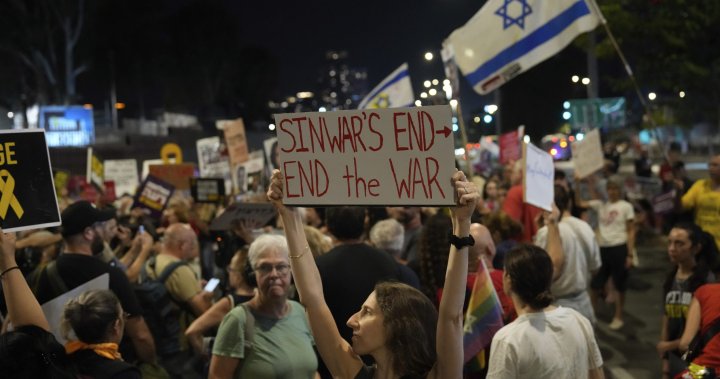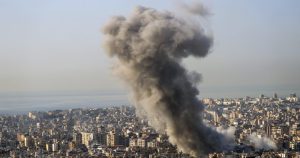Gaza fighting appears likely to continue after Hamas leader Sinwar’s death – National

Hamas confirmed Friday that its leader, Yahya Sinwar, was killed by Israeli forces in Gaza and reiterated its stance that hostages the militant group took from Israel a year ago will not be released until there is a cease-fire in Gaza and a withdrawal of Israeli troops.
The group’s staunch position pushed back against a statement by Israeli Prime Minister Benjamin a day earlier that his country’s military will keep fighting until the hostages are released and will remain in Gaza to prevent a severely weakened Hamas from rearming.
The conflicting stands signal continued deep resistance on both sides to ending the war, even as President Joe Biden and other world leaders press the case that Sinwar’s death is a turning point that should be used to unlock stalled cease-fire negotiations.
The standoff comes as Israel’s war with Lebanon’s Hezbollah — a Hamas ally backed by Iran — has intensified in recent weeks.
Hezbollah said Friday it planned to launch a new phase of fighting by sending more guided missiles and exploding drones into Israel. The militant group’s longtime leader, Hassan Nasrallah, was killed in an Israeli airstrike late last month, and Israel sent ground troops into Lebanon earlier this month.
Sinwar, the former lead of Hamas, died “confronting the occupation army until the last moment of his life,” said his Qatar-based deputy, Khalil al-Hayya, who represented Hamas during several rounds of cease-fire negotiations. Hamas will not return any of the hostages, al-Hayya said, “before the end of the aggression on Gaza and the withdrawal from Gaza.”

Hamas heralded Sinwar in a statement, calling him a hero for “not retreating, brandishing his weapon, engaging and confronting the occupation army at the forefront of the ranks.”
The statement appeared to refer to a video the Israeli military circulated of Sinwar’s apparent last moments in which a man sits on a chair in severely damaged building, badly wounded and covered in dust. In the video, the man raises his hand and flings a stick at an approaching Israeli drone.
Sinwar was the chief architect of the Hamas raid on Israel last year that killed some 1,200 people, mostly civilians, and kidnapped another 250. Israel’s retaliatory offensive in Gaza has killed over 42,000 Palestinians, according to local health authorities, who do not distinguish combatants from civilians but say more than half the dead are women and children.

Get daily National news
Get the day’s top news, political, economic, and current affairs headlines, delivered to your inbox once a day.
The war has destroyed vast swaths of Gaza, displaced about 90% of its population of 2.3 million people and has left them struggling to find food, water, medicine and fuel.
Sinwar’s killing appeared to be a chance front-line encounter with Israeli troops on Wednesday, and it could shift the dynamics of the Gaza war even as Israel presses its offensive against Hezbollah with ground troops in southern Lebanon and airstrikes in other areas of the country.
Hezbollah has fired rockets into Israel nearly every day since the Israel-Hamas war began, displacing tens of thousands of Israelis from their homes in the country’s north. More than 1 million people in Lebanon have been displaced by Israel’s aerial bombardment and ground offensive.
Iran, which also supports Hamas, hailed Sinwar Friday as a martyr who can inspire others in challenging Israel.
“We, and countless others around the world, salute his selfless struggle for liberation of the Palestinian people,” Iran’s foreign minister, Abbas Araghchi, wrote on the X social media platform. “Martyrs live forever, and the cause for liberation of Palestine from occupation is more alive than ever.”

Israel has pledged to destroy Hamas politically in Gaza, and killing Sinwar was a top military priority. But Netanyahu said in a speech announcing the killing Thursday night that “our war is not yet ended.”
Still, the governments of Israel’s allies and exhausted residents of Gaza expressed hope that Sinwar’s death would pave the way for an end to the war.
U.S. Defense Secretary Lloyd Austin said Friday Sinwar’s death provides “an extraordinary opportunity to achieve a lasting cease-fire” and suggested the U.S. could have a role in helping to stabilize Gaza in the future. “Hopefully countries in the region will step up there,” Austin said at a NATO meeting in Brussels.
Italy’s Prime Minister Giorgia Meloni, meeting with her counterpart in Lebanon, said European countries are working for a “sustainable cease-fire” in both that country and in Gaza. Lebanese Prime Minister Najib Mikati said “a diplomatic solution should overcome” the fighting.
But a day after Biden labeled Sinwar’s death an “opportunity for a ‘day after’ in Gaza without Hamas in power,” he acknowledged the difficulty of forging a cease-fire there, saying it might be easier to negotiate a stop to the fighting in Lebanon.
“It’s going to be harder in Gaza,” Biden told reporters Friday after meeting with European leaders in Berlin.
A White House national security spokesman, John Kirby, said it was “too soon” to assess who Hamas “might anoint as Sinwar’s successor and what that individual may be willing to pursue.”

In Israel, families of hostages still held in Gaza demanded the Israeli government use Sinwar’s killing as a way to restart negotiations to bring home their loved ones. There are about 100 hostages remaining in Gaza, at least 30 of whom Israel says are dead.
“We are at an inflection point where the goals set for the war with Gaza have been achieved, all but the release of the hostages,”
Ronen Neutra, father of the Israeli-American hostage Omer Neutra, said in a video statement. “Sinwar, who was described as a major obstacle to a deal, is no longer alive.”
Netanyahu was planning to convene a special meeting Friday to discuss hostage negotiations, an Israeli official with knowledge of the negotiations said. The official spoke on the condition of anonymity to discuss confidential information.
Israel’s military said Friday it allowed 30 trucks of food, water, medical and other supplies into northern Gaza, as the country faces pressure from the U.S. to ramp up aid. There was no immediate confirmation from the U.N. that the aid arrived and was being distributed in the north.
In Lebanon, Hezbollah issued a statement early Friday saying its fighters have used new types of precision-guided missiles and explosive drones against Israel for the first time in recent days.

The statement appeared to refer to an explosives-laden drone that evaded Israel’s multilayered air-defense system and slammed into a mess hall at a military training camp deep inside Israel last Sunday, killing four soldiers and wounding dozens. The group announced earlier this week it fired a new type of missile called Qader 2 toward the suburbs of Tel Aviv.
The Israeli military said Friday it would activate an additional reserve brigade to the north of its country to support troops battling in southern Lebanon. The Lebanese health ministry said six people were killed in the past 24 hours of fighting, bringing the death toll over the past year to 2,418, a quarter of whom were women and children.
On Friday Israel said its forces killed two militants who crossed into Israeli territory south of the Dead Sea from neighboring Jordan. Such infiltrations are relatively rare, especially as Israel has ramped up border security since the Hamas attack in October 2023.
Sewell reported from Beirut. Associated Press reporters Bassem Mroue in Beirut, Jon Gambrell in Jerusalem and Josh Boak in Berlin contributed to this story.
#Gaza #fighting #appears #continue #Hamas #leader #Sinwars #death #National







